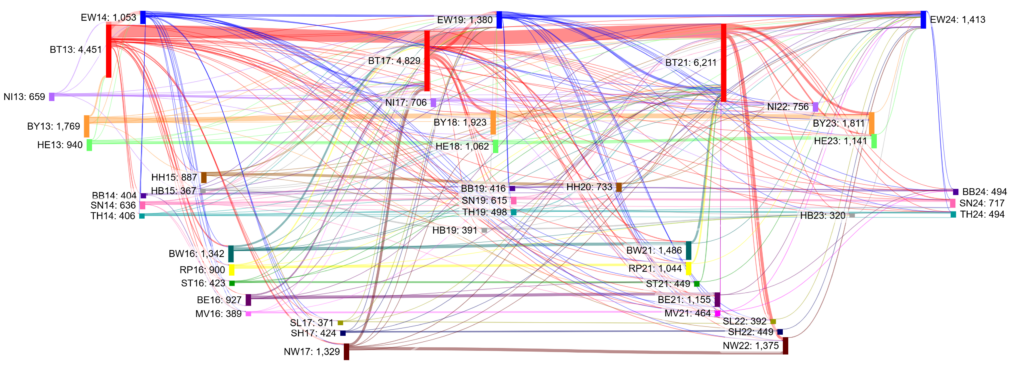 Without candidates, elections would be impossible. They fulfill an important task for the functioning of parliamentary democracy by providing the voters with a choice on the ballot. During its project on candidate nomination for the 2017 Bundestag election, IParl researched who was running, who decided on the chances of success of any given candidacy and which criteria affected nominations. Based on these findings, the CandiData-project aims at identifying long-term developments in candidate selection. Do the same persons compete on every occasion or do the parties renew their candidate supply? Are there recognizable patterns by which the candidates manoeuvre the multi-level electoral systems in Germany? Under which conditions will candidates be nominated in a way that allows them to enter parliament?
Without candidates, elections would be impossible. They fulfill an important task for the functioning of parliamentary democracy by providing the voters with a choice on the ballot. During its project on candidate nomination for the 2017 Bundestag election, IParl researched who was running, who decided on the chances of success of any given candidacy and which criteria affected nominations. Based on these findings, the CandiData-project aims at identifying long-term developments in candidate selection. Do the same persons compete on every occasion or do the parties renew their candidate supply? Are there recognizable patterns by which the candidates manoeuvre the multi-level electoral systems in Germany? Under which conditions will candidates be nominated in a way that allows them to enter parliament?
 To answer these and more questions, CandiData provides a continuously growing dataset. During the first project phase, we gathered the complete records of all candidates at 47 elections at the state and federal level as well as from elections to the European Parliament in Germany between 2013 and 2025. The dataset is expanded with every new election. Additionally, we strive to include candidates from elections before 2013 to improve our long-term analysis capabilities.
To answer these and more questions, CandiData provides a continuously growing dataset. During the first project phase, we gathered the complete records of all candidates at 47 elections at the state and federal level as well as from elections to the European Parliament in Germany between 2013 and 2025. The dataset is expanded with every new election. Additionally, we strive to include candidates from elections before 2013 to improve our long-term analysis capabilities.
If you have any questions or comments, please contact Dr Danny Schindler and/or Daniel Hellmann.
To date, the CandiData project has produced the following publications and working papers:
Young adults are descriptively underrepresented in parliaments worldwide - a fact that has attracted increasing scholarly and institutional attention in recent years. While most research has focused on institutional and contextual factors that explain cross-national variation in descriptive youth representation, less attention has been paid to the role of political parties as "gatekeepers" to elected office. This gap persists despite a growing body of literature on supply-side explanations and voter evaluations of candidate age. In this paper, we study candidate selection as an indicator of parties' descriptive inclusiveness and a crucial stage for shaping legislative composition. We focus on the case of Germany, a particularly valuable context given its mixed-member proportional electoral system, strong party-centred candidate selection processes, and notable variation in parliamentary youth representation across parties and regions. Drawing on a novel dataset of over 50,000 candidacies for all elections at the federal level and the state level since 2013, our core question runs: What drives the nomination of young candidates (conceptualized as being under 31 years old)? More specifically, we analyse whether the share of young nominees is related to factors on the individual/candidate level, the party level and the institutional level. We first assess the share of young candidates across party lists, followed by a weighted measure that accounts for their actual chances of entering parliament. Our analyses show that while the overall share of young candidates has increased over time, several factors shape this development: party ideology (with progressive parties fielding more youth), the share of incumbents, the total number of candidates, and the type of candidacy; young candidates are notably underrepresented in district races. Furthermore, we find evidence for the 'sacrificial lamb' thesis, as young nominees are often placed in lower list positions and less winnable districts than their older counterparts.
Presented:
Section Conference "How to govern now? Current challenges of German coalition democracy" of the DVPW Section "Government System and Governance in the Federal Republic of Germany" and the Schader Foundation on 22 and 23 May 2025 in Darmstadt.
Global Conference on Parliamentary Studies: Reinventing Democracy for the 21st Century, 13 June 2025, Athens.
ECPR Standing Group on Parliaments, 2 to 4 July 2025, Barcelona.
Although immigrants and their descendants constitute a significant proportion of Western European societies, they remain descriptively underrepresented in political institutions. This has fuelled scholarly debate on political representation, participation, and party politics, highlighting voter biases, parties' reluctance, supply-side factors, and institutional constraints. The paper investigates candidate selection - a crucial stage for shaping legislative composition and reflecting descriptive inclusiveness of parties - in Germany, a country with a long immigration history but only recent increases in immigrant-origin politicians (mainly at the national level). Germany's multi-level system and similar electoral frameworks at the state level offer a compelling case to study these dynamics. Drawing on a novel dataset of over 50,000 candidacies in national and state elections since 2013, we analyse differences in immigrant candidacy across time, parties, levels of government, and electoral tiers. A weighted candidacy measure accounts for the candidates' chances to enter parliament, enabling us to explore whether not being born in Germany (alongside factors like gender and age) serves as individual advantage or disadvantage, and whether the selection of immigrant candidates varies depending on the level of government and electoral tiers.
Presented:
ECPR Standing Group on Parliaments, 2 to 4 July 2025, Barcelona.
Aus dem Westen importiert? Wer tritt bei den Ostwahlen an by Daniel Hellmann
In September, voters in Saxony, Thuringia and Brandenburg will be called upon to elect new state parliaments. Once again, it is to be expected that identity as an East German will also play a role in the East German elections. As studies show, East Germans hold very few leading positions in relation to their share of the population - even in the new federal states themselves. Whether this also applies to the candidates standing for election is analysed below. Are East Germans descriptively over- or under-represented among the candidates? How has this developed over time? And is the attribution "East German party" also reflected in the candidate portfolio?
Wer tritt eigentlich zur Europawahl an? by Daniel Hellmann
To coincide with the European elections, Daniel Hellmann, Research Fellow at the Institute for Parliamentary Research, analyses the socio-demographic profile of the candidates who want to enter the European Parliament this year. Based on current data, he argues that many a cliché about the European Parliament - keyword: "If you have a grandad, send him to Europe" - cannot be upheld. Instead, empirical evidence shows that seats in the European Parliament are particularly competitive and that the field of candidates is younger than in the 2021 Bundestag elections, for example.
2022: Kein Anzeichen von Niedergang. Die personelle Erneuerung der Parteien bei der Kandidatenaufstellung für Bundestags- und Landtagswahlen by Daniel Hellmann and Danny Schindler
As part of the new IParl research project CandiData, the range of candidates put forward by the parties for parliamentary elections in Germany is being analysed longitudinally. To date, all candidates nominated for state, federal and European elections since 2013 have been analysed. In this Focus section, we present the project and, as a first step, examine the question of how high the renewal rate of the parties, understood as the proportion of newcomers among all candidates, is. Newcomers are defined as people who have never stood for election before - whether in the constituency or on the party list and regardless of the candidate level (state, federal, European). It turns out that around six out of ten nominees were standing for the very first time. This is not a sign of the often claimed decline of the parties. There is also clearly no downward trend for the period under review.
Always the same old faces? - Candidate turnover and the recruitment power of German state level parties, by Daniel Hellmann and Danny Schindler
Finding individuals who are willing to invest time and money in (often unpromising) parliamentary candidacies is a challenging task for parties. In times of decreasing party memberships, it might be even more difficult to find new candidates who did not compete for an election so far. Yet, it is vital for Germany's party democracy that parties can attract candidates and renew their pool of citizens running for public office. This indicates the parties' recruitment power and the overall responsiveness of electoral representation (Koskimaa et al. 2021).
Against this background, the paper investigates the number of candidates and their renewal rate from one election to another, i.e. the share of new faces among them, for all federal and state level elections since 2013. The unique dataset includes more than 40,000 candidacies across 37 elections. While scholars so far primarily focused on one level (such as Manow 2012 for German federal elections and Koskimaa et al. 2021 for Finland), on intraparty advancement (for example Ohmura et al 2018) or on the multilevel careers of MPs (like Detterbeck 2010), our data allow us to combine those approaches in order to draw a broad picture of multi-level candidacies.
The analysis investigates both legal-institutional factors (like variants of the electoral system and the available parliamentary seats) as well as party specific attributes (like electoral performance and membership size) as determinants of candidate renewal. It reveals that most variables either directly matter or indirectly affect the share of newcomers by altering the overall number of candidates running. Moreover, we show that parties still attract a surprisingly high share of around 60 per cent new nominees for each election. Hence, they are still able to fulfil their recruitment function in challenging times.
The paper was presented at the annual conference of the Ak Parteienforschung from 7 to 8 October in Trier.
Sign up to receive updates, promotions, and sneak peaks of upcoming products. Plus 20% off your next order.